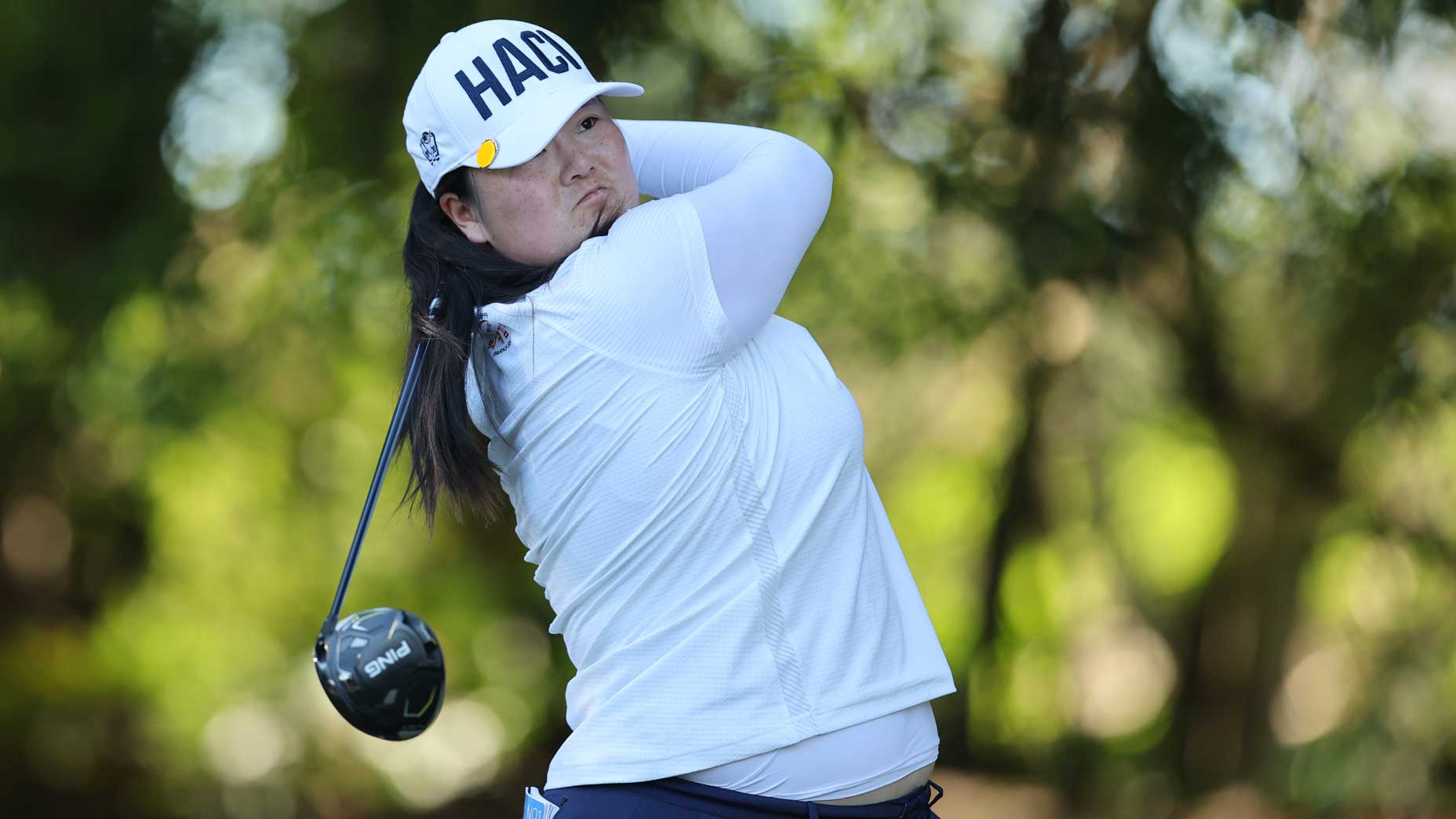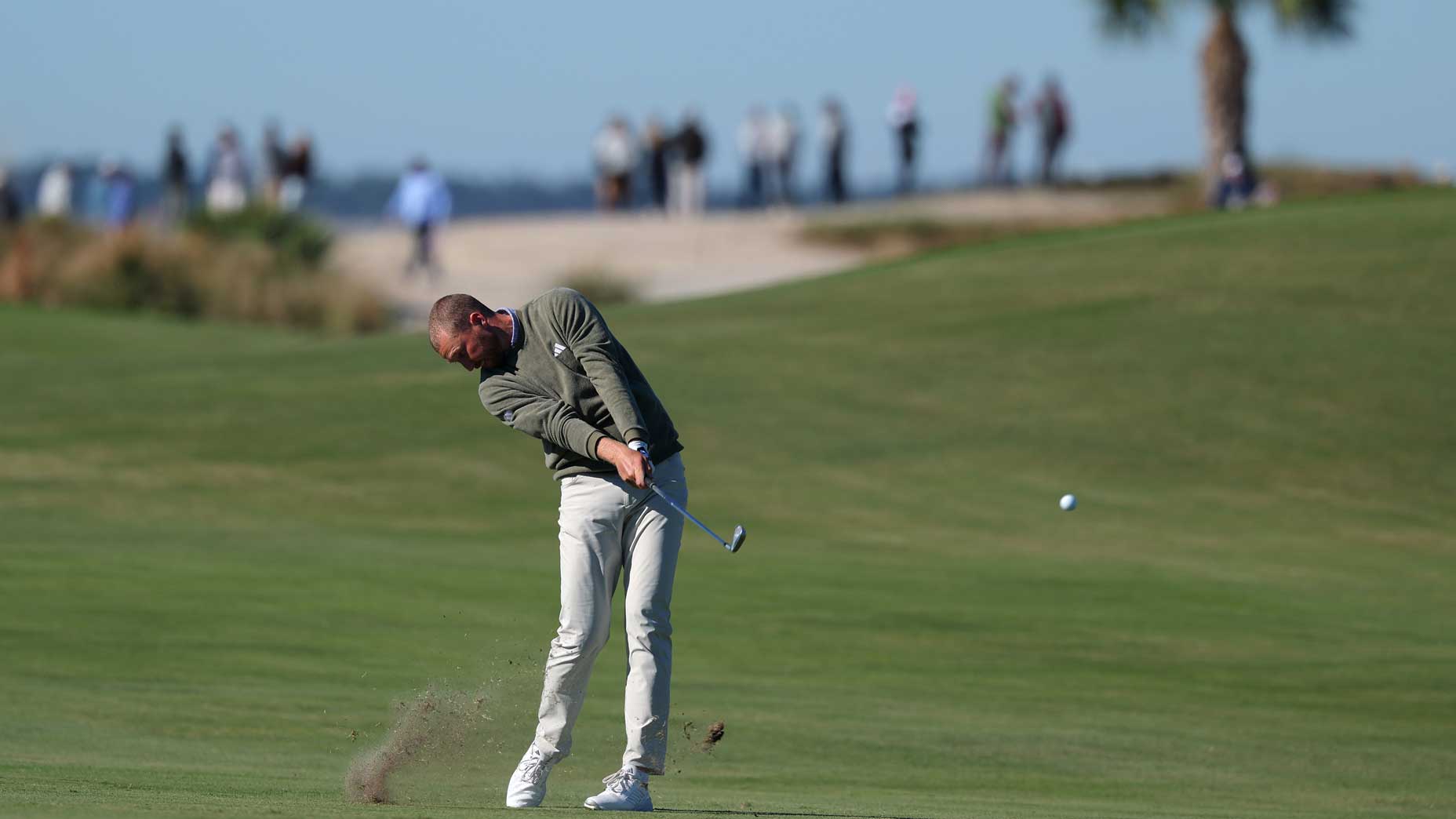Welcome to Wall-to-Wall Equipment, the Monday morning gear wrap-up in which GOLF equipment editor Jonathan Wall takes you through the latest trends, rumors and breaking news.
Tiger’s ‘Milled Grind’ irons
The intricate sole geometry on Tiger Woods’s irons adds another level of difficulty to the creation process. But if recent photos of his TaylorMade P7TW prototypes tell us anything about how they were designed, it’s very likely Woods won’t have to worry about the grind being bang-on from head to head in the future.
Interesting nugget on Tiger’s new @TaylorMadeGolf P7TW irons: They’ll be the first to have company’s Milled Grind sole. (Visible on the 5-iron.) pic.twitter.com/dbkNdTOjFp
— Jonathan Wall (@jonathanrwall) January 25, 2019
According to TaylorMade, Tiger’s P7TW irons are the first set to feature the company’s Milled Grind sole. Introduced with the Milled Grind wedges, each sole is individually CNC milled to ensure accuracy and consistency from club to club. Moving away from a hand ground sole to a CNC milled product gives TaylorMade the ability to use a milling machine to create an identical version when players, particularly those on TOUR, need a replacement.
For Woods, that would mean being able to request a new set of irons with identical sole geometry to what he’s used in the past. For someone who notices even the most subtle differences, the Milled Grind process would take a lot of the tedious sole work out of the equation, making it easier for Woods to break in a set with relative ease.
Finau goes G410
Tony Finau was one of nine players in the field at the Farmers Insurance Open who chose to give Ping’s G410 Plus driver a shot. For Finau, the switch came down to finding a build that helped him remove the right miss, which he was able to negate with the new driver.
“He felt like he was overcutting it sometimes,” said Ping Tour rep Christian Pena. “He’s a [G400] Max guy and with G410 Plus, he was able to cut the ball but wasn’t seeing the same miss that was there in the past.”
Nine players converted to @PingTour G410 Plus driver at Torrey, including Tony Finau and Gary Woodland. pic.twitter.com/H7XH5qEPua
— Jonathan Wall (@jonathanrwall) January 25, 2019
With a free week ahead of Torrey Pines, Finau made the trip to Ping’s Phoenix headquarters to test the driver. During the session, Finau saw less spin on his mis-hits, with a more controlled flight, when the CG weight was placed in the heel.
Finau initially tried a 16-gram weight in the toe, but the ball cut too much for his liking. To correct the issue, more weight was placed on the face and the tungsten weight reduced to 10 grams — and positioned in the heel — to pick up ball speed, lower spin and produce Finau’s controlled fade shot shape.
“If we can get the weight in the heel, that’s where the closure rates are going to be faster,” said Pena. “The ball speeds are going to be amazing, and that’s where [Tony] is right now.”
Scott’s experiment pays off
Not all putter experiments produce a runner-up finish the first time around. For Adam Scott, switching to the arm-lock putting method popularized by Matt Kuchar — whereby the grip rests against the forearm — saw him come within two shots of catching Justin Rose while ranking 14th in strokes gained: putting with a custom Scotty Cameron Tour Fastback putter.
“Making the putter change was a pretty good experiment this week, it worked nicely,” Scott said. “Definitely something to build on. See what happened the next time I come out, see if it feels just as good. Yeah, I learned a lot with that style of putting this week and it was quite a big adjustment, I have to say, and I made some errors out there with it, but hopefully — it’s looking all positive and I like that. Twenty-eight putts four straight days is probably the best I’ve ever done.”
Having never used the technique in the past, Scott admitted there were putts from certain lengths that took more time to get acclimated to than others, due to the longer-than-normal putter grip.
“Just the severity of angles on that putter I used this week,” he said. “All of a sudden six degrees of loft and the grip is three inches in front of the blade, a little fiddly getting into position. And when I didn’t put it in the right position, it was in a more natural position, I didn’t start putts where I was intending. So I missed a couple really short putts throughout the week, which was carelessness, but it’s interesting, different feeling certainly setting up with this putter.”
Custom irons for Day
Jason Day logged two wins last season despite ranking 142nd in strokes gained: approach-the-green on the PGA Tour. Day’s iron situation consisted of TaylorMade’s P750 and P730 — he started using P730 at the Masters — as he sought to find a solution to lower ball flight and eliminate a left miss.
The solution was a custom set of P760 irons that were built during the brief offseason. The progressive design has hollow-body long and mid irons (3-7) — comprised of a 1025 carbon-steel body and SUS630 steel face insert — featuring low-density Speed Foam material inside the cavity.
Given Day’s requirement to mitigate the left miss, TaylorMade added a custom tungsten weight that shifted the center of gravity towards the toe.
“That’s one area that I’ve been working probably my hardest is my iron play,” said Day. “You know, that’s one thing that I just got to keep working and hopefully the hard work, just slowly I gain confidence and it slowly brings results. Last year I struggled with the left shot, especially with the miss. It would constantly go left and I struggled with that a lot. I think with the 760s, we moved the CG a little bit further to the toe with some tungsten weight in the toe. Granted, doing that hopefully will straighten that left shot out a little bit.”
Rose’s constant
Justin Rose hasn’t skipped a beat since he transitioned into Honma equipment at the Desert Classic. The lack of a learning curve is partly due to Rose having the freedom to play the golf ball of his choosing. In Rose’s case, he chose to continue with TaylorMade’s TP5, the same ball he played before parting ways with the brand at the end of last year.
Rory McIlroy, who underwent a significant equipment switch when he jumped from Titleist to Nike in 2013, was forced to learn on the fly after signing a deal that included the golf ball. He repeated the same process when he moved to TaylorMade in 2017 and admitted it took some time to get acclimated to the new ball.
“I think the big thing is [Justin] hasn’t changed the golf ball,” McIlroy said. “The one thing that you hit all the time with every single shot is the golf ball, so to still have that constant in there, you can make that change and I don’t think there’s any sort of freak-out moment. I think when you change 14 clubs and go into a new golf ball, that’s when it can — it takes a while. It definitely took me a while. It took me a good six or nine months.”
Back to black
One of the interesting quirks about Cameron Smith’s equipment setup is that nearly every club in his bag has an all-black look — from the head color down to the shaft and grip. Smith’s preferred look can be found on his putter and wedges — although he’s currently gaming wedges without the Jet Black finish — but it wasn’t until recently that he was able to add all-black irons to the bag with the release of Titleist’s 718 AP2 and AP3 Black. Smith added a full set of 718 AP2 Black with KBS $-Taper shafts featuring a black PVD finish.
FIRST LOOK: @Titleist’s new 718 AP2 Black and AP3 Black irons. https://t.co/Vrj6VOfgo0 pic.twitter.com/knonvp43WB
— Jonathan Wall (@jonathanrwall) January 17, 2019
“I couldn’t wait to get the course on Monday morning,” Smith said. “I think I was the first player there and the box was waiting for me on the Titleist Tour Van. I was like a 10-year old kid on Christmas morning opening a new present. They’re sick. I love the look and feel and can’t wait to put them in play.”
Rory’s Spider test
Rory McIlroy’s initial run with TaylorMade’s Spider prototype putter in Hawaii produced promising results, but that didn’t stop him from testing multiple hosel adjustments and sightlines to verify he was in the best possible setup at Torrey Pines.
Through the testing session, McIlroy confirmed the No. 3 hosel with a single, long sightline was a suitable setup for his current putter.
Rory McIlroy gives TaylorMade’s Spider prototype putter the green light. pic.twitter.com/RFNhGqWeX0
— Jonathan Wall (@jonathanrwall) January 4, 2019
“He was returning the loft perfectly at 2-degrees, which is great for any greens in the country, or in the world,” said Chris Trott, TaylorMade’s director of sports marketing. “He was returning the lie angle every time the same, within one half of a degree, which is exceptional.”
Champ’s Blueprint
Cameron Champ made the switch to Ping’s Blueprint prototypes official after finding a shaft setup that produced the necessary spin numbers and launch characteristics to knock his iBlade irons from the bag.
Champ settled on True Temper Dynamic Gold X100 Tour Issue shafts after testing them in advance of the first round.
Had a chance to get a peek at @PingTour’s Blueprint Forged irons. One thing stuck out to me… ? https://t.co/97vD4h6L6f pic.twitter.com/juRnOtJAh8
— Jonathan Wall (@jonathanrwall) December 21, 2018
“It launched a little higher for him with more spin, which is something we were going for,” said Ping Tour rep Christian Pena. “He loves the look and wanted to play them, but we just needed to dial-in the whole build, including the shaft.”
Quick-Hitters: Aaron Wise and Branden Grace transitioned into Callaway’s Epic Flash Sub Zero driver. … Grace (6X) and Peter Uihlein (8X) switched to Fujikura’s Ventus shaft. … Honma announced Justin Rose’s “Rose Proto” irons will be available at retail March 15. … Patrick Reed followed Paul Casey’s lead and added a single Honma TW-U utility 4-iron to the bag. … Hideki Matsuyama switched to a 19-degree Ping G410 hybrid. … Bryson DeChambeau logged his second win in three months with Cobra’s King F9 Speedback driver (9 degrees; TPT 14MKP shaft) in the bag. … Billy Horschel returned to a Ping Karsten B60 putter, the same model he used to win the 2014 FedExCup. … Rickie Fowler plans to employ special edition Puma stand bags during a few events this season.







